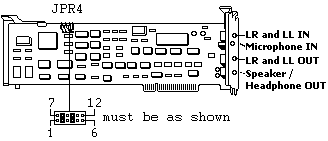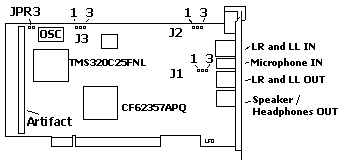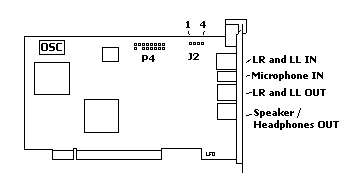|
M-ACPA
@6e6c.adf
Audio
Capture/Playback Adapter/A Option Disk
IBM M-ACPA Win. driver Corrective Serv.
M-Audio Capture Drivers and APIs 1 of 2
M-Audio Capture Drivers and APIs 2 of 2
M-Audio Capture Drivers Docs
M-Audio Support files for Windows 3.1
Drivers
for Audio Capture/Playback
Readme
file for macpaopt.exe
190-159
M-Audio Capture And Playback Adapter/A Upgrade Kit
190-160
M-Audio Capture And Playback Adapter/A Withdrawn
Installing the
M-ACPA under Win95 (NOT on my site you don't!)
ACPA Construction
ACPA Source
ADF Sections
ACPA (ACPA Rev. A)

ACPA (ACPA Rev. B)

Artifact There is a long
double row of soldering spot with 60 pins. What was that intended
for ? A SCSI-Interface ? A card-connector for a Wavetable daughter-card
? It is missing on the Ultimedia ACPA, which is functionally identical
and has the same chips.
JMP3- Leave jumpered. Why this is,
I don't know.
Peter sez-
Did you notice the 40-pin double pin row solder spots
on that card ? As far as I recall it was intended to add some more stuff
to this card ... and this jumper seems to be an artifact from that stage
of developement as well. Open the jumper - and the system hooks with the
ACPA installed.
J1 This is where you can hook
up your CD Rom Audio cable.
1 = GND
2 = CD Audio R
3 = CD Audio L
J2 AUX
1 = GND
2 = AUX In R
3 = AUX In L
ACPA (Ultimedia Rev. C)

J2
1 = CD Audio In R
2 = GND
3 = GND
4 = CD Audio In L
P4 = Multimedia Frontpanel
(undocumented)
ACPA Construction
Brad Parker said:
I know Audiovation sounds really good, and specs out good
to, but I'm working on an audio related project that needs to run under
Linux, so the ACPA series cards are my only real choice, unless you know
of a OSS compatible Audiovation driver for Linux.
I Looked at both the M-ACPA/A and ARPA audio stages tonite
and they are functionally identical (Think you said that on your page).
Four small transistors near the center are for the Microphone
gain stage and are probably acting as an impedance matching circuit, the
two small transistors near the top act as buffers for the line in stage.
Three additional gain blocks are made up of the three quad operational
amplifiers marked TL084C, the C being CMOS. These are low noise, hi impedence
devices that use bi-fet transistor technology internally. Each TL084 contains
four Op-Amp devices. Generally they sound good and
can be considered an "upgrade" part.
The "speaker" outputs, and I use that term loosely, are
powered by two LM386 power Op-Amps. They will drive headphones, but are
not known for their fidelity. They could be bypassed, yeilding a second
set of line outputs. I'll poke around with an osciliscope but I think the
spot where the inputs come in through the coupling capacitors, marked C35
and C36 on M-ACPA and C15 and C17 on ARPA, looks likely.
I just noticed that ARPA only has 3 voltage regulators,
while M-ACPA has 4. The LM 317 and LM 337 imply a dual rail power supply
with a positive and a negative rail on the M-ACPA, while ARPA appears single
ended. This could mean that M-ACPA has more dynamic range, greater output
levels and less TIM distortion than ARPA. The 317/337 pair are adjustable,
so I don't know what their output voltage is, but if I designed the thing,
I'd tap the +/- 12 volt and regulate it 10 or 11 volts.
ACPA Source
Brad Parker said:
Been looking at the IBM ACPA source very carefully, trying
to figure out how it works. I have noticed many very interesting details.
Here's what I think I know:
ACPA works a lot like Mwave, in that there is a TI DSP
that it is loaded with an operating system (ACPA OS?). This indicates that
Mwave followed IBM's usual evolutionary, not revolutionary model.
The ACPA OS runs the programs that play, record and loopback.
Dave Weis ported the OS and it loads and runs the playback program he also
ported. There is only 8K of memory on it, so I don't think a Soundblaster
emulation like Mwave's is possible. I'm going to add record capability
by porting the record program module.
The card dosen't use interrupts, it reads and writes directly
to I/O ports, MCA superiority at work. Looks like it can be treated as
a block device which means that direct DAT record/playback (ala SGI) is
possible. That's a job for whoever supports the mt utility.
The ACPA supports just about every sample rate I can think
of, including a 48K professional format that was used with M-motion and
would probably work with DAT and ADAT. ACPA also supports a mono 88K rate,
which would make very good quality recordings. The only major one missing
is the current 96K fad. Of course we are only recording with 16 bit resoulution,
not 20 or 24 bit like the modern stuff. Then again, they have to down convert
to put it on a 16 bit CD. I read on the Pro Audio NG that bit rate and
sample rate conversion is a big pain. The concensus there is to record
at the sample rate and resolution of your target media, 16 bit 44.1 Khz,
or for commercial reproduction, 16 bit 48 Khz
I think the most interesting thing I found out is that
the original IBM driver supports up to 4 ACPAs concurrently! Keeps track
of the seperate stereo audio streams and everything. Very nice for my purposes.
Don't think OS/2 every took advantage of that. Hopefully the Linux stuff
will work out that way :-)
If I can pull this off, I'm going to attempt a port for
Audiovation. I finally got a copy of the Mwave developer's kit. It's very
Win 3.XX orientated, but the Soundblaster emulator might be ported to work
with Linux directly, without all the dual boot monkey business that goes
on now.
AdapterId 06e6c
"ACPA/A"
Address Selection
The base address of the ACPA/A can be at one of 4 different
locations. Choose a location which does not conflict with any other installed
board.
<"FDC0-FDC7">, FDC8-FDCF,
FDD0-FDD7, FDD8-FDDF, Disable
Interrupt Selection
Interrupt level used. Minimize the amount of interrupt
sharing by assigning other installed boards to different levels.
<"Interrupt 3">,
4, 5, 6, 9, 10, 11, 12
9595 Main Page
|


